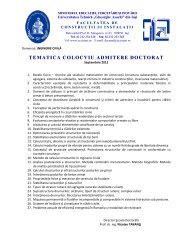Studii privind utilizarea algelor marine ca sorbent low-cost pentru ...
Studii privind utilizarea algelor marine ca sorbent low-cost pentru ...
Studii privind utilizarea algelor marine ca sorbent low-cost pentru ...
You also want an ePaper? Increase the reach of your titles
YUMPU automatically turns print PDFs into web optimized ePapers that Google loves.
<strong>Studii</strong> <strong>privind</strong> <strong>utilizarea</strong> <strong>algelor</strong> <strong>marine</strong> <strong>ca</strong> <strong>sorbent</strong> <strong>low</strong>-<strong>cost</strong> <strong>pentru</strong> îndepărtarea ionilor metalici<br />
din ape uzate<br />
O valoare a debitului soluţiei de alimentare de 8 mL/min a fost considerată optimă, şi a<br />
fost menţinută în obţinerea celorlalte curbe de străpungere.<br />
VII. 3. Evaluarea eficienţei sorbţiei ionilor de Cd(II) pe amestec de <strong>sorbent</strong> în condiţii<br />
dinamice<br />
c/c 0<br />
1<br />
0.8<br />
0.6<br />
0.4<br />
0.2<br />
0<br />
0 500 1000 1500<br />
V, mL<br />
35<br />
35 mg/L<br />
46 mg/L<br />
57 mg/L<br />
Figura VII. 2. Curbele de străpungere obţinute experimental <strong>pentru</strong> sorbţia ionilor de Cd(II) pe amestec de<br />
<strong>sorbent</strong> (alge <strong>marine</strong> + Purolite A-100 = 1:2), la diferite valori ale concentraţiei iniţiale (pH=5,0; debit = 8<br />
mL/min; H = 2,5 cm, temperatură = 20 °C).<br />
După cum se poate observa din Figura VII. 2, deşi toate curbele de străpungere au<br />
forma generală de „S”, aliura lor depinde de concentraţia iniţială a ionilor de Cd(II) din soluţia de<br />
alimentare.<br />
VII. 4. Modelarea curbelor de străpungere obţinute experimental<br />
Reprezentarea grafică a acestor dependenţe liniare este redată în Figura VII. 3, iar valorile<br />
<strong>ca</strong>lculate ale parametrilor <strong>ca</strong>racteristici sunt prezentaţi în Tabelul VII. 5.<br />
ln c0/(ct-1)<br />
3<br />
2.5<br />
2<br />
1.5<br />
1<br />
0.5<br />
0<br />
(1): y = -1.3411x + 2.1908; R 2 = 0.9934<br />
(2): y = -2.1272x + 2.4857; R 2 = 0.9815<br />
(3): y = -3.3455x + 2.8261; R 2 = 0.9903<br />
(1): 35 mg/L<br />
(2): 46 mg/L<br />
(3): 57 mg/L<br />
0 0.2 0.4 0.6 0.8 1 1.2<br />
V, L<br />
ln ct/(c0-ct)<br />
1.5<br />
1<br />
0.5<br />
0<br />
-0.5<br />
-1<br />
-1.5<br />
-2<br />
-2.5<br />
(1): 35 mg/L<br />
(2): 46 mg/L<br />
(3): 57 mg/L<br />
(1): y = 0.0111x - 1.9824;<br />
R 2 = 0.9873<br />
(2): y = 0.0187x - 2.39; R 2 = 0.9647<br />
(3): y = 0.0284x - 2.8424; R 2 = 0.9979<br />
0 50 100 150 200<br />
t, min<br />
(a) (b)<br />
Figure VII. 3. Reprezentarea liniară a modelului Thomas (a) şi Yoon-Nelson (b) <strong>pentru</strong> sorbţia Cd(II) pe<br />
amestec de <strong>sorbent</strong> (alge <strong>marine</strong> + Purolite A-100 = 1 :2).<br />
Se poate observa că valorile constantei Thomas s<strong>ca</strong>d odată cu creşterea concentraţiei<br />
ionilor de Cd(II) din soluţia apoasă. În acelaşi timp, <strong>ca</strong>pacitatea de sorbţie în regim dinamic





